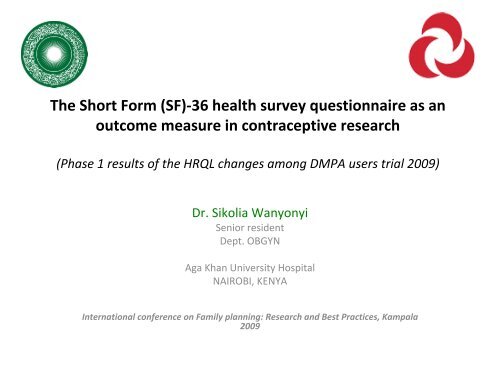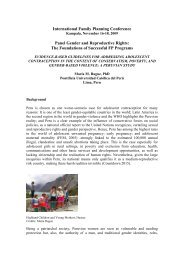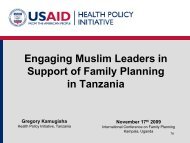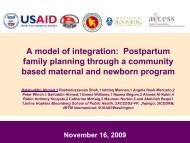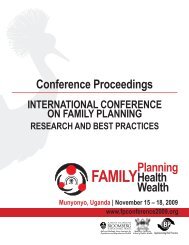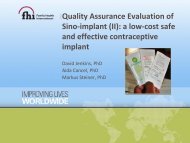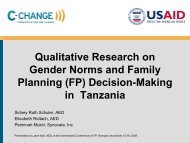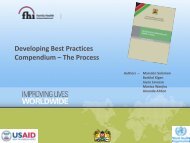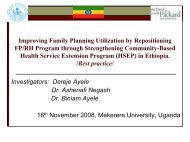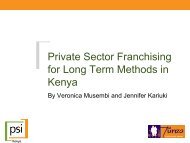The Short Form (SF)-36 health survey questionnaire as an outcome ...
The Short Form (SF)-36 health survey questionnaire as an outcome ...
The Short Form (SF)-36 health survey questionnaire as an outcome ...
You also want an ePaper? Increase the reach of your titles
YUMPU automatically turns print PDFs into web optimized ePapers that Google loves.
<strong>The</strong> <strong>Short</strong> <strong>Form</strong> (<strong>SF</strong>)‐<strong>36</strong> <strong>health</strong> <strong>survey</strong> <strong>questionnaire</strong> <strong>as</strong> <strong>an</strong><br />
<strong>outcome</strong> me<strong>as</strong>ure in contraceptive research<br />
(Ph<strong>as</strong>e 1 results of the HRQL ch<strong>an</strong>ges among DMPA users trial 2009)<br />
Dr. Sikolia W<strong>an</strong>yonyi<br />
Senior resident<br />
Dept. OBGYN<br />
Aga Kh<strong>an</strong> University Hospital<br />
NAIROBI, KENYA<br />
International conference on Family pl<strong>an</strong>ning: Research <strong>an</strong>d Best Practices, Kampala<br />
2009
•<br />
•<br />
•<br />
•<br />
•<br />
•<br />
Introduction<br />
Objective<br />
Methods<br />
Data m<strong>an</strong>agement<br />
Results<br />
Conclusions<br />
Outline<br />
2
•<br />
•<br />
•<br />
•<br />
Introduction<br />
Contraceptive is often a lifestyle choice<br />
It could impact on the quality of life (QoL) of users<br />
Focus h<strong>as</strong> been on side effects <strong>an</strong>d contraceptive efficacy<br />
<strong>The</strong> effect of contraceptives on QoL could also affect<br />
acceptability, uptake <strong>an</strong>d discontinuation rates<br />
Trussell et al. Fam Pl<strong>an</strong> Pers 1999(31); www.who.int<br />
3
•<br />
•<br />
•<br />
Introduction<br />
Contraceptive users are presumably a <strong>health</strong>y population<br />
Knowledge on contraceptive related QoL ch<strong>an</strong>ges is essential<br />
for uptake <strong>an</strong>d continuation of use<br />
QoL tools e.g. <strong>SF</strong>‐<strong>36</strong>, have not been adequately used in<br />
contraceptive research<br />
Trussel et al. Fam Pl<strong>an</strong> Pers 1999(31), Brazier JE et al. BMJ 1992(308), Garrat et al. BMJ 1993(306)<br />
4
Characteristics of Me<strong>as</strong>ures of Health-related Quality of Life<br />
Approach Strength Weakness<br />
Generic Instruments e.g.<br />
<strong>SF</strong>‐<strong>36</strong><br />
Specific instruments<br />
(condition or population<br />
specific)<br />
•Single instrument needed<br />
•Detects different <strong>as</strong>pects of<br />
<strong>health</strong> status<br />
•Comparisons across<br />
conditions possible<br />
•Clinically sensible<br />
•More responsive<br />
Guyatt, G. H. et. al. Ann Intern Med 1993;118:622-629<br />
•May not focus adequately<br />
on area of interest<br />
•Cross‐condition<br />
comparisons not possible<br />
•Limited in population <strong>an</strong>d<br />
intervention<br />
5
•<br />
•<br />
•<br />
What Makes <strong>SF</strong>‐<strong>36</strong> a good HRQL me<strong>as</strong>ure?<br />
High signal‐to‐noise ratio<br />
–<br />
Responsiveness enh<strong>an</strong>ced<br />
Validity<br />
–<br />
Consistency with theoretically derived predictions<br />
Interpretability<br />
–<br />
Differences between patients small/trivial<br />
Guyatt, G. H. et. al. Ann Intern Med 1993;118:622-629; http://www.r<strong>an</strong>d.org<br />
6
Main Objective<br />
To determine the internal consistency <strong>an</strong>d reliability of<br />
<strong>Short</strong> <strong>Form</strong> (<strong>SF</strong>)‐<strong>36</strong> <strong>health</strong> <strong>survey</strong> <strong>questionnaire</strong>s<br />
among users of DMPA<br />
7
Research question<br />
•<br />
Methods<br />
Is the <strong>SF</strong>‐<strong>36</strong> a reliable tool in <strong>as</strong>sessing the effects of contraceptives<br />
on the <strong>health</strong> related quality of life?<br />
Main <strong>outcome</strong> me<strong>as</strong>ures<br />
•<br />
<strong>The</strong> eight scales of the <strong>SF</strong> <strong>36</strong> <strong>health</strong> <strong>survey</strong> profile<br />
Setting<br />
•<br />
<strong>The</strong> Aga Kh<strong>an</strong> University Hospital <strong>an</strong>d Family Health Options clinics,<br />
Nairobi, Kenya.<br />
8
Mode of administration of <strong>SF</strong>‐<strong>36</strong> Questionnaire<br />
•<br />
•<br />
Interviewer‐b<strong>as</strong>ed<br />
–<br />
–<br />
–<br />
Maximizes response rate<br />
Few if <strong>an</strong>y missing items<br />
Minimizes errors of misunderst<strong>an</strong>ding<br />
Other modes<br />
–<br />
–<br />
–<br />
Telephone<br />
Self administered<br />
Surrogate responders
•<br />
•<br />
•<br />
•<br />
Analysis: SPSS version 15.0<br />
Inter scale correlations‐<br />
Data m<strong>an</strong>agement<br />
Kline’s criterion of 0.4<br />
Internal consistency‐ Cronbach’s α (Nunnally’s criterion of<br />
0.7)<br />
Sub group <strong>an</strong>alysis done<br />
Kline P. A. H<strong>an</strong>dbook of test construction, London 1986; Nunnaly JL. Psychometric theory ,NY 1978<br />
10
Study flow<br />
147 Screened<br />
131 recruited<br />
107 met eligibility criteria<br />
( For 6 months follow-up)<br />
16 Declined<br />
24 excluded<br />
11
•<br />
•<br />
•<br />
•<br />
•<br />
Me<strong>an</strong> age: 31.4 years (SD 5.8)<br />
Results<br />
Average family size: 1.7 children<br />
Marital status: 90.8% married<br />
Level of education: 78.7%<br />
tertiary<br />
53% were contraceptives naive prior to DMPA<br />
12
Internal consistency of <strong>SF</strong> <strong>36</strong> <strong>health</strong> <strong>questionnaire</strong><br />
<strong>SF</strong> Scale Items Alpha Me<strong>an</strong> Item scale<br />
correlation<br />
Physical Functioning 10 0.89 82.63 0.44<br />
Social Functioning 2 0.56 77.61 0.39<br />
Role limitation/physical 4 0.83 82.79 0.55<br />
Role limitation/emotional 3 0.79 76.83 0.55<br />
Energy fatigue 4 0.62 67.20 0.29<br />
Mental <strong>health</strong> 5 0.75 71.39 0.38<br />
Pain 2 0.73 79.05 0.57<br />
General Health 5 0.59 73.95 0.23<br />
NB: Reliability is considered acceptable if α exceeds 0.7 or Item scale<br />
correlations above 0.4<br />
13
•<br />
•<br />
•<br />
Conclusions<br />
<strong>SF</strong>‐<strong>36</strong> is a potential me<strong>as</strong>ure of <strong>outcome</strong> among<br />
contraceptives users<br />
It is acceptable, internally consistent <strong>an</strong>d a reliable me<strong>as</strong>ure<br />
of <strong>health</strong> status<br />
This tool should be tested <strong>an</strong>d modified among FP users for<br />
possible adoption by researchers <strong>an</strong>d providers<br />
14
•<br />
•<br />
•<br />
Conclusions<br />
Knowledge of the impact of contraceptives on QoL could lead<br />
to better uptake of FP <strong>as</strong> a lifestyle choice<br />
Motivated <strong>an</strong>d informed users are less likely to discontinue<br />
contraceptive methods chosen<br />
Specific psychometric tools could also be developed <strong>an</strong>d<br />
adopted<br />
W<strong>an</strong> GJ et al. Contraception 2007(7); Sonnenberg FA et al. Contraception 2004(69); Hubarcher<br />
D et al. Contraception 1999(60)<br />
15


